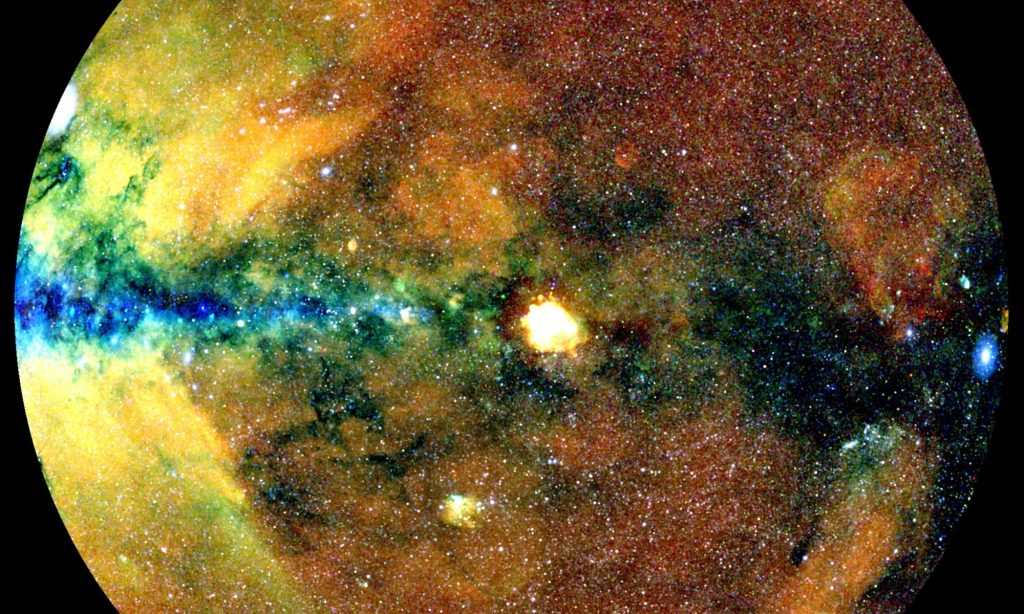
In the realm of science fiction, there’s a classic notion of individuals gaining X-ray vision, allowing them to see through solid objects. However, this remains a physical impossibility for our human eyes. Nonetheless, astronomers have devised a solution to this challenge, enabling us to explore the Universe using X-ray vision.
Known as X-ray astronomy, this field has a six-decade history. It unveils some of the cosmos’s most energetic and turbulent phenomena, including luminous quasars, supernova bursts, intergalactic streams of hot gas, and youthful, fiery stars.
Astronomers from the eROSITA consortium at the Max Planck Institute for Extraterrestrial Physics have recently unveiled the newest collection of X-ray data derived from the eROSITA survey. Encompassing half of the X-ray sky, this dataset divulges details about 900,000 individual X-ray sources.
This surpasses the total number of X-ray sources detected throughout the history of X-ray astronomy, encompassing discoveries from Chandra and other orbiting observatories over decades.

eROSITA serves as a soft X-ray imaging telescope mounted on the Spectrum-RG satellite. Its initial comprehensive survey of the entire sky, known as eRASS1, spanned 7 months commencing on December 12, 2019.
Operating at its highest sensitivity, the telescope identified 170 million X-ray photons, enabling the cameras to precisely gauge their energies and arrival times.
Under the leadership of principal investigator Andrea Merloni, the astronomy team compiled an initial catalog of data. Additionally, they authored over 50 new scientific papers stemming from their discoveries.
Following the completion of the initial survey, the instrument conducted three additional scans of the entire sky from June 2020 to February 2022. This vast collection of X-ray data will be made available soon. For further insights into the mission, please watch the video below.
eROSITA’s Treasury of X-ray Sources
X-ray astronomy concentrates on the study of intense and dynamic phenomena in the cosmos. These include the cores of galaxies, which harbor supermassive black holes, as well as supernova explosions, newly formed stars, and other regions where matter becomes heated to extremely high temperatures.
The preliminary eRASS1 dataset identifies approximately 710,000 supermassive black holes, 180,000 X-ray emitting stars within the Milky Way, and 12,000 clusters of galaxies. Additionally, it encompasses a select number of other unique sources such as X-ray-emitting binary stars, supernova remnants, pulsars, and various celestial objects.
These are mind-blowing numbers for X-ray astronomy,
says Andrea Merloni, eROSITA principal investigator and first author of the eROSITA catalog paper. We’ve detected more sources in 6 months than the big flagship missions XMM-Newton and Chandra have done in nearly 25 years of operation.
The initial data release from eROSITA offers a comprehensive, “multi-faceted” view of the sky across various X-ray wavelengths. Each wavelength conveys valuable insights to astronomers about the nature of the objects and events emitting the X-rays. Furthermore, the consortium furnishes additional information for every set of images and data provided.
Included are catalogs detailing source classifications, celestial coordinates, energy levels, and precise timestamps of photon arrivals to the instrument.
We’ve made a huge effort to release high-quality data and software,
added Miriam Ramos-Ceja, who leads the eROSITA Operations team. We hope this will broaden the base of scientists worldwide working with high-energy data and help push the frontiers of X-ray astronomy.

Zeroing in on Specific X-ray Objects
The primary scientific goals of eROSITA involve utilizing X-rays to identify the hot intergalactic medium within 50 to 100,000 galaxy clusters and groups. Additionally, it investigates the hot gas present in filaments connecting these structures, which emit X-ray radiation.
The instrument is also assigned the mission of identifying accreting black holes concealed within galaxies. Additionally, it explores the physics of X-ray sources within galaxies, such as pre-main-sequence stars, supernova remnants, and X-ray binaries.
One of the papers accompanying the latest survey data utilizes X-ray information to refine cosmological models by studying clusters of galaxies. Additionally, in one of the released images, we observe a newly identified filament of material.
This filament extends from a section of the galaxy cluster Abell 3667 to the adjacent cluster Abell 3651. Such findings could aid astronomers in gauging the quantity of matter present in the “warm-hot intergalactic medium,” offering valuable insights into the formation of expansive structures such as galaxy clusters within the Universe.
The eRASS1 survey also captures the nearby Virgo Cluster of galaxies, offering a means to investigate vast filamentary structures. Astronomers, in particular, seek to comprehend the physical phenomena occurring within the outskirts of these immense galaxy clusters.
Utilizing the latest survey data alongside other comprehensive all-sky images, a team of scientists delved into the composition of the cluster’s periphery. This investigation encompassed high-energy emissions surrounding galaxies and groups within the cluster. Additionally, they examined a phenomenon referred to as a “320-kiloparsec-long X-ray extension” near the galaxy M49.

eROSITA’s Past Work and Future
Since its launch in June 2019, eROSITA has propelled X-ray astronomy forward significantly. Commencing operations in October of the same year, it has provided high-resolution X-ray observations of the universe. While surveying the sky, it detected changes in a distant quasar known as SMSS J114447.77-430859.3. Read more about it here.
These alterations provide insights into the expansion of the black hole located at the core of the quasar. eROSITA detected fluctuations in brightness at the quasar’s core, suggesting that the black hole absorbs some of the material that ventures into its event horizon. Meanwhile, other material is expelled in the form of potent winds.
The device has additionally identified a nascent black hole in the ancient Universe and mapped the presence of hot gas throughout our Milky Way Galaxy. It achieved its initial operation on October 22, 2019. Presently, it is in safe mode as technicians evaluate its condition and functionality.
This article was initially published on Universe Today. You can find the original article here.





